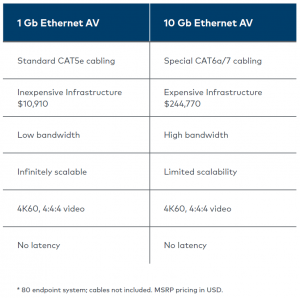Get Real About Switch Costs: Ethernet is Cheap
I hear it all the time – “10G switches are expensive!”
Can that really be true? In every area of IT and computer hardware, components are cheap and they get cheaper. Is it possible that 10G Ethernet switches are the expensive exception?
In a word: No.
Cisco – a leader in really expensive Ethernet switches – admitted in 2016 that “[In 2006], a single 10G switch port cost you $4,000. But [in 2016], the cost has dropped to under $150 per port.”
If 10G switches were already cheap three years ago, then who is misleading us to believe otherwise today?
In 2018, Crestron® published the DigitalMedia™ DM NVX Application Design Guide. In this post I have excerpted a table from that document, comparing 1G and 10G infrastructure.
Crestron claims that an 80-port 10G switch costs $244,770. Yet here in reality, CDW will sell you a NETGEAR 10G switch, preconfigured for SDVoE with 80 ports of 10GBaseT copper for $12,763.88, and that’s before you get a 5% discount by merely signing up for an account. The same switch configured with 80 fiber optic ports is even cheaper ($9,573.88).
Important: if you are still paying a quarter million dollars for an 80 port 10G switch, please call me immediately. I will happily sell you one for half that price.
Kidding aside, don’t miss their claim that an 80-port 1G switch costs nearly $11,000. Why are Crestron so interested in the narrative that Ethernet switches – 10G and 1G both – are so expensive?
Why lie?
On the surface, it seems like the ’10G/1G debate’ is a central battle in the pro AV industry of 2019. But it’s really not. Many companies sell AV over IP gear restricted to 1 Gbps functionality. Every one of these products has exactly the same set of problems:
- Flawed image quality
- Noticeable latency
- Proprietary encoding, ensuring no compatibility between manufacturers
It isn’t fair to these lower-end 1G products to be compared to SDVoE. SDVoE technology delivers flawless image quality without latency. Only the matrix switch and SDVoE on a 10G network can meet that standard. Performance compromise is guaranteed when you squeeze a 4K image into a 1G pipe – even if you sprinkle perfect pixie dust on your codec. Learn more about how codecs trade performance for bandwidth at SDVoE Academy (free login required).
A 10G Ethernet switch can do as much as a high end AV matrix switch, and more. Yet the matrix costs more than the 10G switch – much more. A Crestron DigitalMedia™ 32×32 switch, configured with 24 HDBaseT inputs and 24 HDBaseT outputs has a list price of $59,200. Comparatively, a NETGEAR M4300-48X offers 48 ports of 10GBaseT, each of which could be used for input or output, for $4,799.99.
The matrix switch costs $1,233 per port, while the 10G switch costs $100 per port.
So then why has ’10G vs 1G’ been such an important theme for so many in the industry? Perhaps it’s to distract you from the fact that SDVoE and 10G Ethernet are a powerful and extremely affordable alternative to the venerable matrix switch.
Notes: the Crestron DM NVX Application Design Guide was accessed here. Crestron pricing was accessed here. Both documents were accessed on 25 February 2019.



